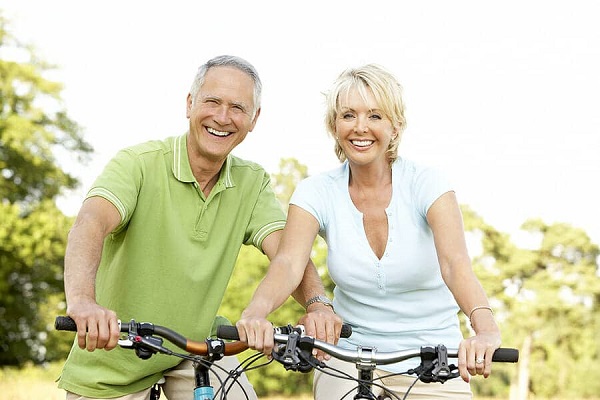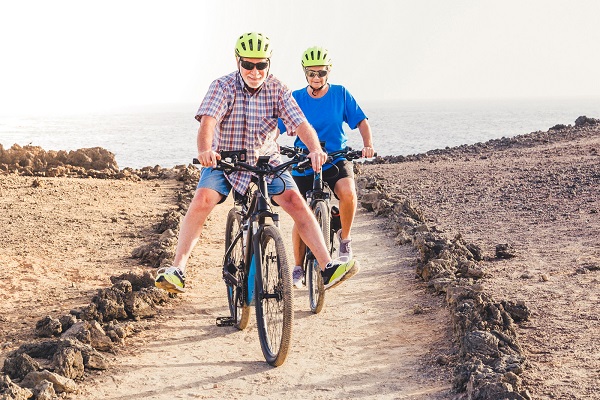Workout for aging is something widely discussed. With aging comes new health concerns and with each concern, there is a need for new workout routines. Following the trend, cycling has become one of the most widely accepted sports for older people in Singapore. Usually, office workers look down on cycling as a mere form of transportation. But the real benefits of cycling are now becoming widely visible. Here are a few health benefits of cycling that are good to know if you are working on making good use of your exercise time.
Is cycling good for over 50s?

Cycling for over 50s is definitely a good idea. There are several health benefits of cycling that make it the perfect way to keep their minds active and active enough to maintain overall fitness levels in older adults. Most importantly, there are 10 things you should know if you decide on getting into this form of exercise. By following these tips, one can remain physically fit throughout his or her life by enjoying an exciting ride once they hit retirement age. Let’s discover the stationary bicycle stands.
Cycling for older adults is not a high-risk option. Most studies show that cycling at an intensity of less than 60% of VO 2 max produces no additional health problems. The effects on cardiovascular function are equivalent to walking or jogging, and the benefits seem particularly applicable in those with other physical limitations such as osteoporosis (loss of bone mineral content) which can adversely affect exercise performance by fatigue. Keep reading https://greatestjournal.com/how-do-i-choose-a-beach-cruiser/
Low impact exercise
Upper body and core muscle groups are activated in cycling. We may think that our biking regimen will be too easy to satisfy the needs of a poise, flexible older female (hips). But the truth is that there was ample research done by experts which showed an increase in dynamic hip extension during cycling as evidenced by EMG activity associated with agonist muscles like rectus femoris, adductor Magnus, vastus medialis obliqui as well as internal hip rotators. On the other hand, lower body muscle groups are also targeted in cycling.
Exertion has been found to stimulate a heart rate increase of 24%, specifically within walking and running cycle ergometer protocols that involved pedaling at a cadence ranging from 70 rpms~120 rpm. Another University of Wisconsin Study examined high-intensity interval training versus moderate intensity steady state exercise on leg strength /kick power (i. e. Time to 40% of 1-RM) and found that the intermittent training had the greatest effects on all outcomes tested (Time, trial max squat jump power and muscular endurance ).
Group activity
Because the research has shown a lot about how beneficial cycling for older ladies may be, it is important to make us aware of further studies that prove this premise. A 2006 study from Denver University showed an overall significant gain in functional mobility, independent of age or activity level and also compared aerobic training with resistance training among community-dwelling unsheltered elderly population (>65y). The recovery effects were greatest within the first month, while at 1 year time-point, strength levels of slow-twitch type II muscle fibers were also significantly higher in the physical training group.
Another study that used strength and aerobic testing of senior women. Found improvements after a 6 months exercise program with cycling being most effective compared to walking or skipping rope – while 3hr/day sessions showed better gains than shorter, less frequent exercises although not statistically significant (Number and repeats performed per session did matter but maybe a limitation).
Endurance
When it comes to female cycling, the research is very limited and some of these studies just don’t seem to include anything like Wingate or Cyclus tests. Nevertheless, interestingly enough, this issue has been studied by a group at Stanford University who looked into Aerobic vs Respiratory Models – are our muscles more ‘Blood-Thinner’ (Respirer) than we think?
We’ve also asked what type of workouts make women burn as much fat as men? We are excited to learn that there is some actual evidence out there. A recent study done at the University of Zagreb in Croatia looked into women who did ‘endurance training’ by cycling on a stationary bicycle at strenuous or moderate intensity levels repeatedly over what they call practically every single day for ~6 weeks showed females (and males) gained significantly more fat from their cycling than their sedentary control counterparts.
Cardio & strength workout
Females are believed to be less efficient at using oxygen (or, more specifically, our O2 content in the blood) during aerobic exercise than males. The researchers concluded that females should focus on cardiovascular activities such as running, cycling and swimming. Meanwhile, males are suggested to elevate their intensity through higher repetition efforts while the factor of volume is less critical in female athletes since more reps per session yield a greater gain in strength than increased work rate or heart rate between sets.
Sharpen our mind
Another interesting study was done at Louisiana State University, which looked into the benefits that engaging in sports can have on girls’ mental performance. What did they find? After being randomly split up into one group that engaged with team activities and another control group, researchers found those in the interest prepared task (IT) improved after a workout while those without improvements gained no significant benefit from participation. The results seem to support over 16 years ago when it was noted young women are more likely to participate in team sports than their male counterparts. They are also better able to handle the stress and pressure that are associated with leadership positions.
Look & feel younger
To add some icing to the cake, just as we see in aging sports personalities slacking off over their age and looking beat up, so too are exercising teens likely to look more tired than their exercisers’ counterparts of the opposite sex. In what seems to be yet another prophylactic measure against anti-aging problems (as opposed to an improvement), increased physical activity has also been shown to produce a noticeable skin complexion alteration without having any effect on the overall facial and body line.
Cycling is a great way to stay fit and active as you age. It’s an excellent form of exercise that can help improve your balance, coordination, and cardiovascular health. However, the simple act of pedaling a bike will not be enough to keep you healthy if you’re past 50 years old. The best way to get started with cycling is by choosing the right bike for your age and fitness level.



